Solutions to Exercises in Real
Analysis
Li Gongbao
School of Mathematics and Statistics in CCNU
�
PREFACE
The Preface can be written here
�
CHAPTER
ONE
1. Does there exist an infinite σ-algebra which has only countably many
members?
Solution: No. There exists no such an infinite σ−algebra M which has only
countably members.
T Aj = ∅(i 6= j), then
Proof 1: Claim 1: If X = Sn
i=1 Ai, Ai 6= ∅, Ai ∈ M, Ai
there exists a A ∈ M, A 6= ∅, s.t. AT Aj 6= ∅ and AT Ac
j 6= ∅ for some j ∈
{1, 2,··· , n}.Hence, Aj = (AT Aj)S(AT Ac
j ∈ M,
then X can be written by Sn+1
i=1 Bj,∅ 6= Bj ∈ M,and Bj are pairwise disjoint.
Proof of Claim 1: Put F{A1, A2,··· , An} be the σ-algebra spaned by
A1, A2,··· , An.Since Ai are pairwise disjoint,new numbers different from Ai
can be only producted by union of some Ai’s.However,{S
j∈{1,2,··· ,n} Aj} has at
most 2n numbers.So F{A1, A2,··· , An} is finite.
AT Aj 6= ∅ and AT Ac
implies that AcT Aj = ∅,thus A ⊆ Aj,which contains the relation:
By the definition of M,there exists A ∈ M s.t.A 6∈ F.We claim that
j 6= ∅ for some j ∈ {1, 2,··· , n}.If not,then AT Aj 6= ∅
j) and AT Aj ∈ M, AT Ac
Aj ⊆ A.
[
{j;AT Aj6=∅}
In fact,the above inclusion relation is mutual,for if x ∈ A ⊆ X,then x ∈ Aj
for some j,and AT Aj
6= ∅,so x ∈ S{j;AT Aj6=∅} Aj,which proves that A ⊆
S{j;AT Aj6=∅} Aj.Hence A = S{j;AT Aj6=∅} Aj ∈ F.A contradiction.This com-
def= A1S Ac1.By Claim 1,there exists a C1 ∈ M s.t.C1T Ai 6=
X,then X = A1S A2
6= ∅ for some i,say,i = 1.So A1 is the union of C1S A1 and
∅ and C c1
Now we prove exercise 1.Choose A1 be a nonempty proper subset of
pletes the proof.
T Ai
�
4
C c1
S A1,both of which are nonempty measurable subsets. Thus
by rearranging the subscripts we can write X = A1S A2S A3,where Ai(i =
Ai)[(C c
A1)[
X = (C1
\
\
ABSTRACT INTEGRATION
1
A2,
1, 2, 3)are nonempty measurable proper subsets of X which are mutually
pairwise disjoint.Continuing in this way, we get a countably infinite disjoint
collection {Ai}∞
T Aj = ∅ for i 6= j.
Put M1 = {Ai}∞
i=1,then M1 ⊆ M.Since M is a σ−algebra and M1 is in-
finitely countable,2M1 is a subcollection of M.Hence the cardinality inequality
holds:
i=1 with Ai
2M1 ≤ 2M,
which is a contradiction since the former cardinality is equal to [0, 1] ,greater
than Nwhich is the latter one’s cardinality.(See P25, exercise 3 in the book
of Jiang zejian). We have completed the proof 1.
Proof 2: We give another way to find a countable subset of M by the im-
plication of proof 1, the main tool is Zorn’s lemma(See the remark). Since
M is countable we denote M by {Ai}∞
i=1.Then M is partially ordered by the
set inclusion relation ⊆.
If all totally ordered subsets of M are finite,then X,the whole space,is ob-
viously their common upper bound.Put B0 = X and M1 = M−{B0},apparently
that all totally ordered subsets of M1 is finite,hence their exists a maximal
element B1 ∈ M1 by Zorn’s lemma.
Put
M2 = {Ai|Ai ∈ M, Ai B1} ⊆ M1
T Bc1 6=
We claim that M2 is infinite.If not,then put C = {Ai|Ai ∈ M1, Ai
∅ and Ai
6= Bc1},is infinite,which will lead to a result that the infinite set
{Bi − Ai|Ai ∈ C} ⊆ M2,a contradiction to our assumption.To see this, pick
S B1 ∈ M1
an arbitrary Ai ∈ C,then B1 ⊆ Ai
S B1 since B1 is the maximal element in M1,which implies that
and B1 = Ai
S B1 = X,by this,∅ 6=
Ai ⊆ B1that contradicts to the definition of C.So Ai
B1 − Ai B1.For if B1 − Ai = ∅,then B1 Ai which implies that Ai =
S B1 = X,contradiction to Ai 6= X since Ai ∈ M1.IfB1 − Ai = B1,then
Ai
S B1 6= X,then Ai
S B1.If Ai
�
REAL AND COMPLEX ANALYSIS
A1 = ∅ or Ai Bc1.Therefore the set
{Bi − Ai|Ai ∈ C} ⊆ M2
5
We have proved that M2 is infinite in the above.Applying Zorn’s lemma
to M2 ,there exists a maximal element B2 ∈ M2 with B2 B1.Put
M3 = {Ai|Ai ∈ M, Ai B2} ⊆ M2.
Then M3 is infinite if we replace X by B1 and do the same as above.Hence
there is a maximal element B3 ∈ M3 with B3 B2.Continuing in this way
and we get a countably infinite collection {Bi}∞
i=1 with the property
B0 B1 B2 B3 ···
Contradiction to our assumption of M that M has no infinite totally ordered
subset.
Hence M is bounded to have a totally ordered subset,which we denote
(1)If ˜M1 has no upper bound,then there exists a subsequence {Cni} ⊆
by ˜M1 = {Ci}∞
i=1 ⊆ M.
{Ci} s.t.
∅ = Ci0
Ci1
Ci3
··· Cik
Ci2
k=1 ⊆ M is pairwise disjoint hence is just what we
Cik+1
···
Then the set {Cik+1 − Cik}∞
want to find.
k=1 has the property :
··· Dik
Dik+1
···
(2)If ˜M1 has a upper bound D1,then put ˜M2 = ˜M1 − {D1}.Continuing
in this way,if for some k, ˜Mk = ˜Mk−1 − {Dk−1} has no upper bound,we have
completed the proof; or else,then {Dk}∞
∅ = Di0
Di3
Di2
k=1 ⊆ M is just what we want,and we have completed
Di1
and the set {Dk+1−Dk}∞
the proof 2.
Remark:1. We give the proof that 2N = [0, 1] = C here. For any giv-
en A ⊂ N, set ϕA(n) = { 1,
Let g : A → (0, 1) is given by
0,
g(A) = 0. ϕA(1)ϕA(2) · ··, it is obvious that g is one-to-one. So, 2N ≤ [0, 1].
if n ∈ A;
if n 6∈ A.
�
6
ABSTRACT INTEGRATION
On the other hand, for any x ∈ (0, 1), set Ax = {r; r ≤ x, r ∈ R}, where
R is the set of all the rational in (0, 1). If x, y ∈ (0, 1) and x 6= y, by Berstein’s
theorem, the density of rational in R, Ax 6= Ay. So, (0, 1) ≤ R = 2N.
So, 2N = [0, 1] = C.
2.Zorn’s lemma:Suppose (X,≺) is a partially ordered set.If every totally or-
dered subsets of X has one upper bound,then there exists a maximal element
a ∈ X s.t.for anyx ∈ X,if x ≺ a,then x = a.
2
2. Prove an analogue of Theorem 1.8 for n functions.
Solution: We have the following result.
Theorem 1.80: Let u1, u2, ..., un be real measurable functions on a measurable
space X, let Φ be a continuous mapping of Rn onto a topological space Y ,
and define
h(x) = Φ(u1(x), ..., un(x))
for x ∈ X. Then h : X → Y is measurable.
Proof: Since h = Φ ◦ f, where f(x) = (u1(x), ..., un(x)) and f maps X into
Rn. Theorem 1.7 shows that it is enough to prove the measurability of f.
If R is any open rectangle in Rn with sides parallel to the coordinate
super plane, then R = I1×I2×···×In, where Ii = (ai, bi) ⊂ R1 (i = 1, 2, ..., n)
are open segments and
f−1(R) = u−1
1 (I1)\
2 (I2)\· · ·\
u−1
u−1
n (In).
In fact, for any given x ∈ f−1(R), we have f(x) = (u1(x), ..., un(x)) ∈
i (Ii) for i = 1, 2, ..., n,
i (Ii), we have
R = I1 × I2 × · · · × In and ui(x) ∈ Ii, then x ∈ u−1
i (Ii). On the other hand, for any x ∈ Tn
that is x ∈ Tn
xi ∈ u−1
So f−1(R) is measurable for each open rectangle interval R ⊂ Rn as ui are
measurable on X.
i (Ii), ui(x) ∈ Ii and f(x) = (u1(x), ..., un(x)) ∈ I1 × I2 × · · · × In.
i=1 u−1
i=1 u−1
By Lindel˝of’s Theorem, every open set V is a countable union of open
interval with sides parallel to the coordinate super-plane, V = S Ri, So
f−1(V ) = Sn
2
3. Prove that if f is a real function on a measurable space X such that
{x; f(x) ≥ r} is measurable for every rational r, then f if measurable.
i=1 f−1(Ri) is measurable as well.
�
In fact, for any x ∈ {x; f(x) > α}, there is a n0 such that α < rn0 ≤ f(x),
therefore x ∈ {x; f(x) > α}. On the other hand, rn > α implies that
+∞[
n=1
{x; f(x) ≥ rn} ⊂ {x; f(x) > α}.
REAL AND COMPLEX ANALYSIS
7
Proof: For any α ∈ R1, there is a sequence of rational {rn; n = 1, 2, ...} such
that r1 > r2 > r3 > ... > rn > ... > α with lim
{x; f(x) > α} =
n→∞ rn = α. So
{x; f(x) ≥ rn}.
+∞[
n=1
By the condition, for any given n, {x; f(x) ≥ rn} is measurable, we see
that {x; f(x) > α} is measurable for any α ∈ R1. By Theorem 1.12, f is
measurable.
2
4. Let {an} and {bn} be sequence in [−∞, +∞], prove the following asser-
tions:
n→∞ (−an) = − lim inf
(a) lim sup
n→∞ an;
n→∞ (an + bn) ≤ lim sup
(b) lim sup
n→∞ an + lim sup
the form ∞ − ∞;
(c) If an ≤ bn for all n, then
n→∞ bn provided none of the sums is of
n→∞ an ≤ lim inf
lim inf
n→∞ bn
show by an example that strict inequality can hold in (b).
Proof:
(a) lim sup
n→∞ (−an) = inf
k≥1
sup{−ak,−ak+1, ...} = inf
k≥1
inf{ak, ak+1, ...} = − lim inf
{− inf{ak, ak+1, ...}}
n→∞ an.
= − sup
k≥1
(b) lim sup
[sup{ak + bk, ak+1 + bk+1, ...}]
n→∞ (an + bn) = inf
k≥1
k→∞[sup{ak + bk, ak+1 + bk+1, ...}]
= lim
{an} + sup
≤ lim
{bn}]
k→∞[sup
n≥k
n≥k
n→∞ [sup{bn}]
n→∞[sup{an}] + lim inf
= lim
n→∞ an + lim sup
= lim sup
n→∞ bn.
{ak} = lim inf
k→∞ inf
n→∞ an.
n≥k
{an} ≤ inf
(c) lim inf
n→∞ an = lim
In (b), the strict inequality can hold. For example, let an = (−1)n, bn =
k→∞ inf
n≥k
�
n→∞ bn.
n→∞ an + lim sup
n→∞ an = 1, lim sup
n→∞ bn = 1, but lim sup
8
ABSTRACT INTEGRATION
−(−1)n, then an + bn = 0, lim sup
n→∞ (an +
bn) = 0 < 2 = 1 + 1 = lim sup
2
5. (a) Suppose f : X → [−∞,∞] and g : X → [−∞,∞] are measurable.
Prove that the sets {x; f(x) < g(x)}, {x; f(x) = g(x)} are measurable.
(b) Prove that the set of points at which a sequence of measurable real-valued
functions converges(to a finite limit) is measurable.
Proof: (a1) Suppose f, g are measurable on X, then {x; f(x) < g(x)} is
measurable. Suppose {rn} is the set of rational in R1, we claim that
[{x; f(x) < rn}\{x; rn < g(x)}]
{x; f(x) < g(x)} =
∞[
n=1
In fact,
x0 ∈ {x; f(x) < g(x)} ⇐⇒ f(x0) < g(x0)
⇐⇒ ∃rn0, such that f(x0) < rn0 < g(x0)
⇐⇒ x0 ∈ S∞
n=1[{x; f(x) < rn}T{x; rn < g(x)}].
For any r ∈ R, {x; f(x) < r} and {x; r < g(x)} are measurable s-
ince f, g are measurable on X. So, by the claim we have proved above,
{x; f(x) < g(x)} is measurable.
(a2) By (a1), {x; f(x) = g(x)} = X − [{x; f(x) < g(x)}S{x; f(x) >
(b) Suppose {fn} is a sequence of real-valued measurable functions on
g(x)}] is measurable.
(X, M)(a measurable space), then by Theorem 1.9(c), for any n, m ∈ N, |fn(x)−
fm(x)| is a measurable function as | · | is a continuous function on R1 × R1.
So, {x; |fn(x) − fm(x)| < a} is a measurable set for any a ∈ R1.
Clearly, the set where {fn(x)} has finite limit is given by
}
{x; |fn(x) − fm(x)| <
+∞\
+∞[
A =
\
k=1
N=1
n,m≥N
1
k
by Cauchy’s criterion for convergence.
A is a measurable set because for any n, m ∈ N and k ∈ N, {x; |fn(x)−
k} ∈ M and M is a σ−algebra.
fm(x)| < 1
2
6. Let X be an uncountable set, let M be the collection of all sets E ⊂ X
such that either E or Ec is at most countable, and define µ(E) = 0 in the
first case, µ(E) = 1 in the second. Prove that M is a σ−algebra in X and
�
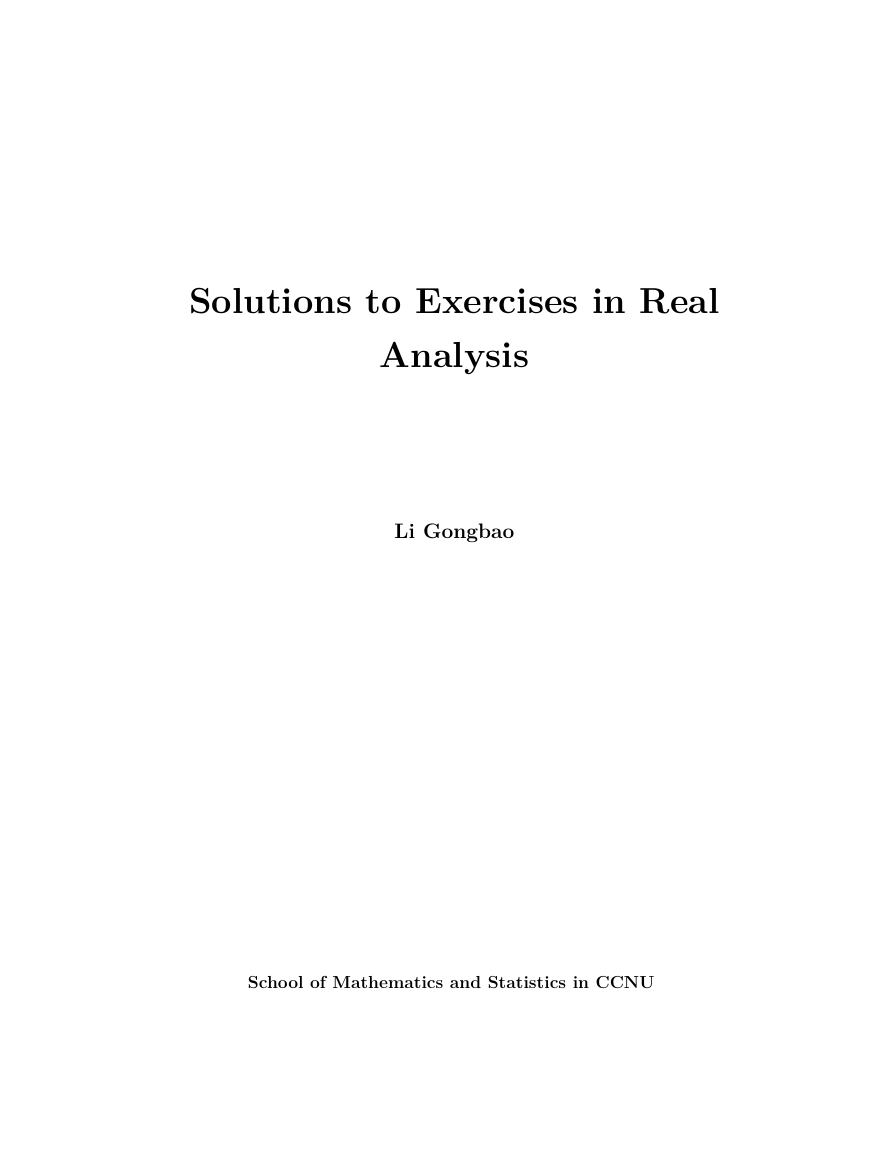
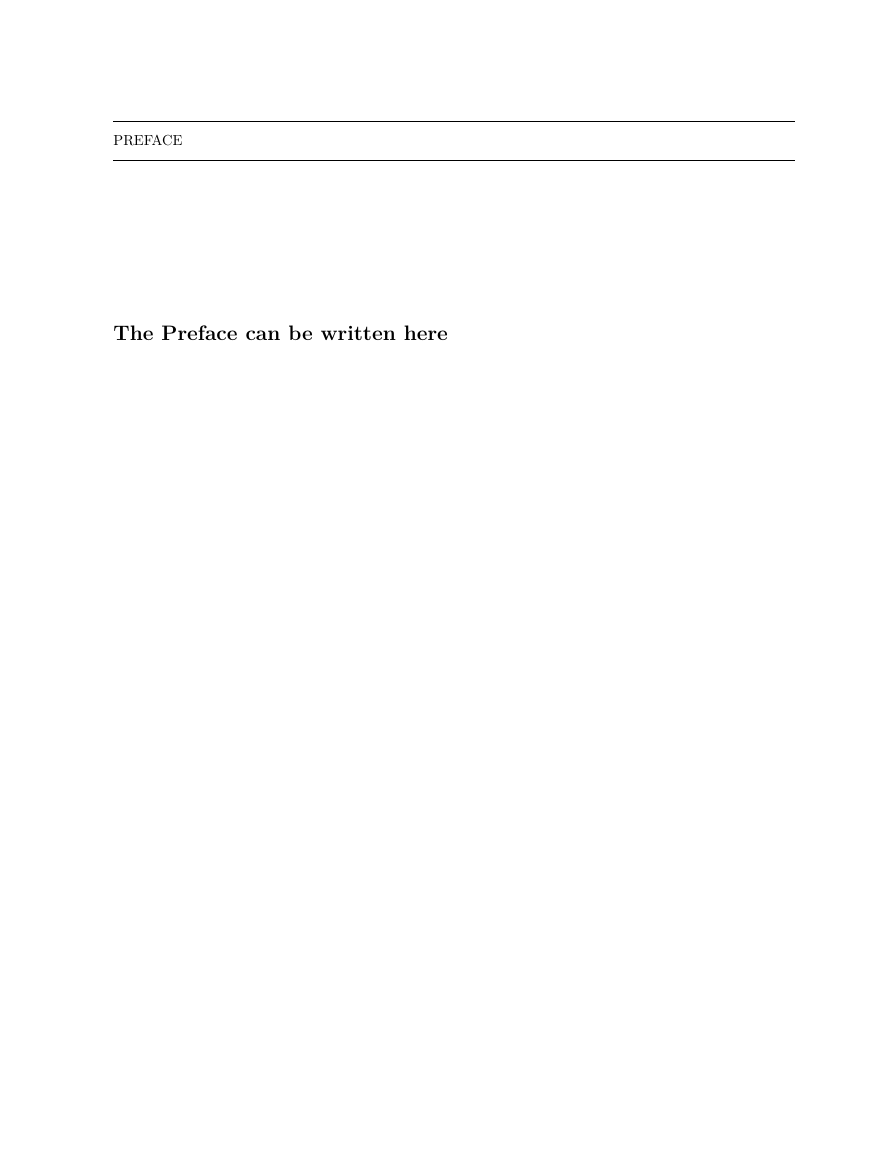
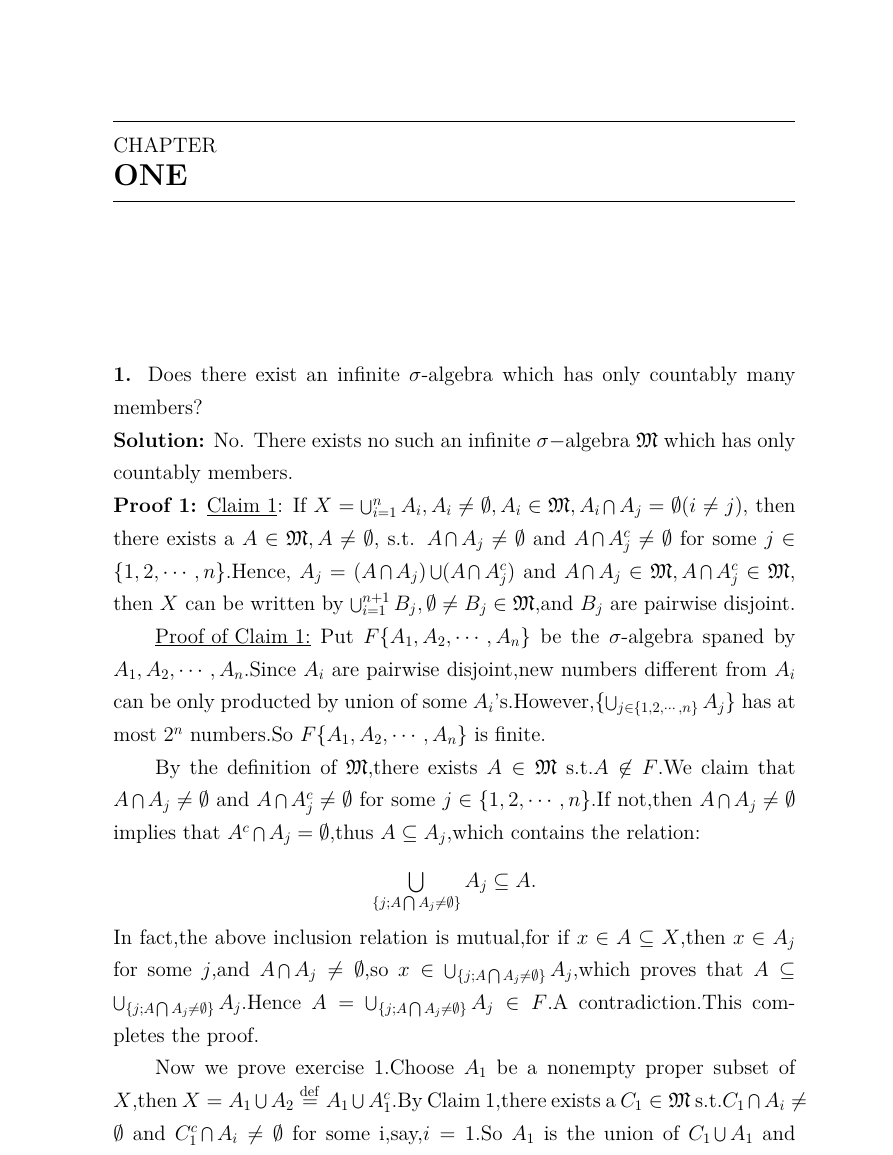
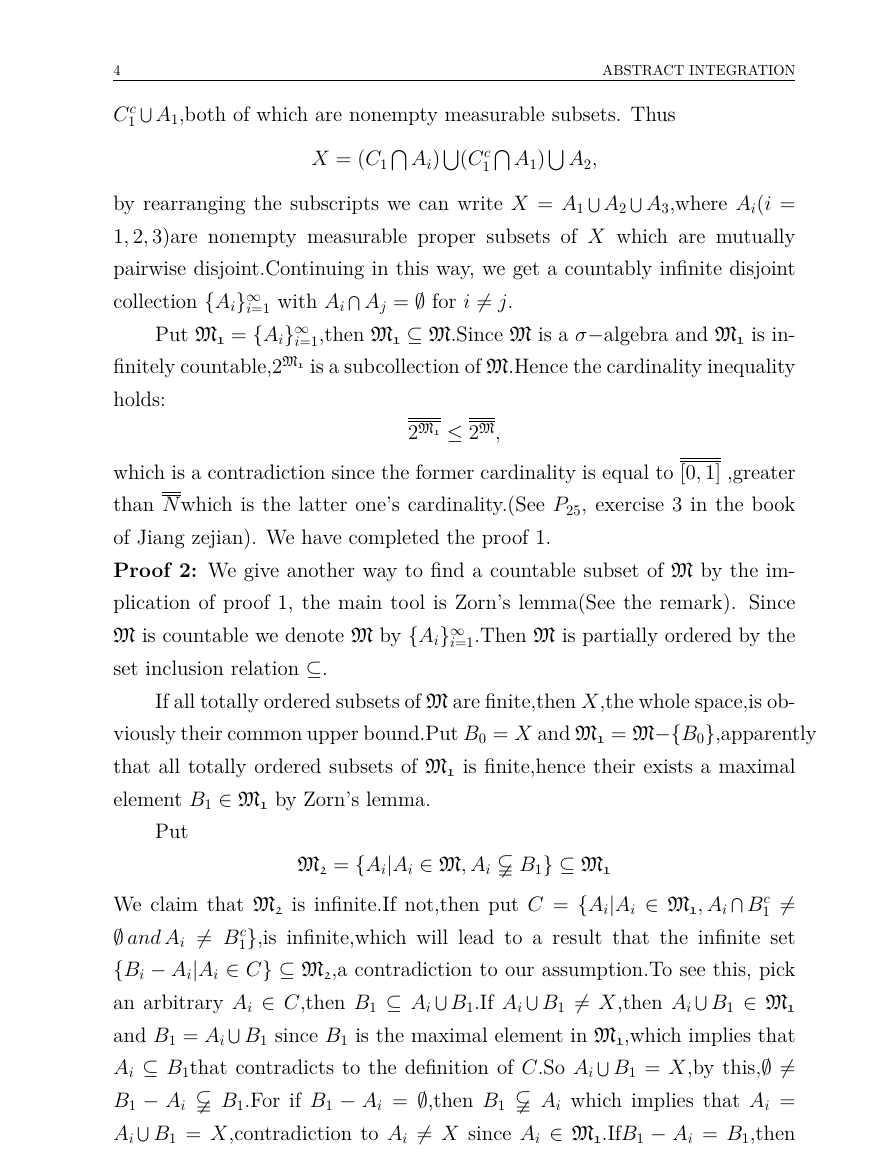
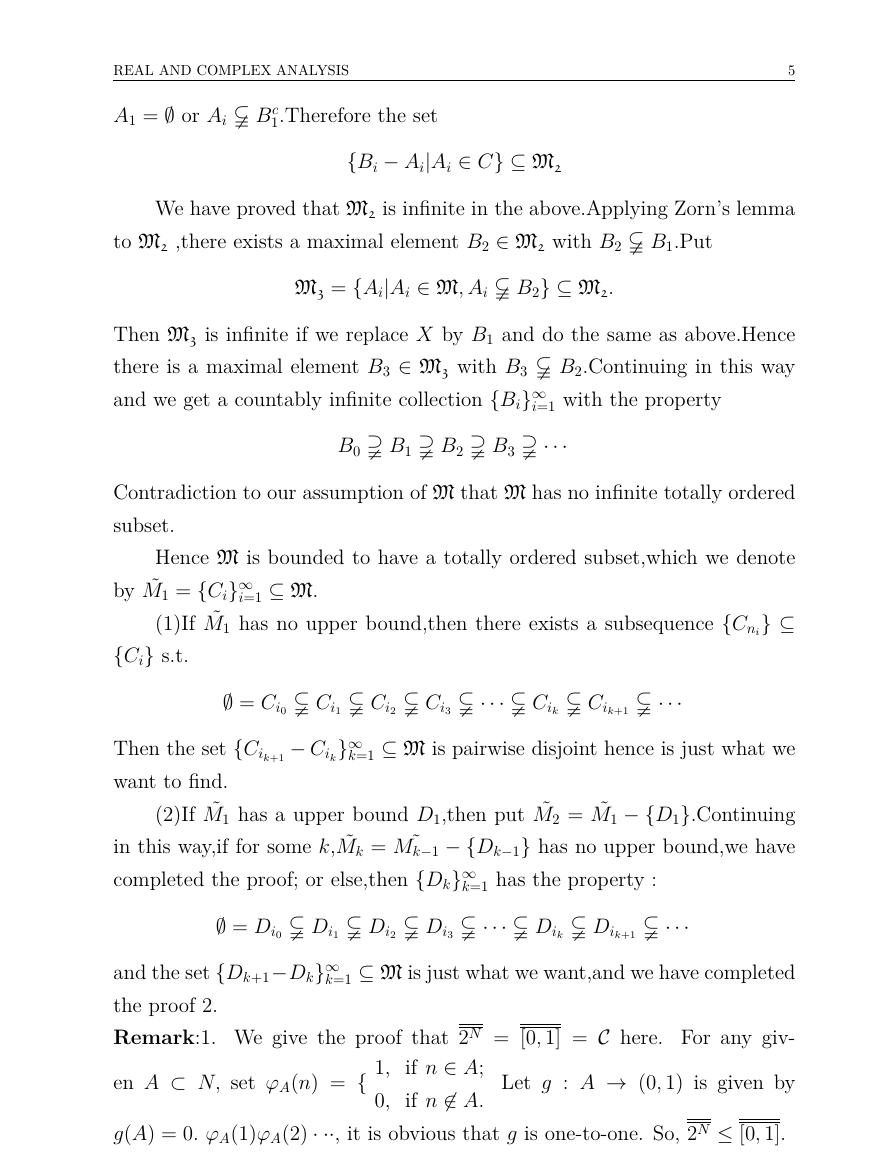
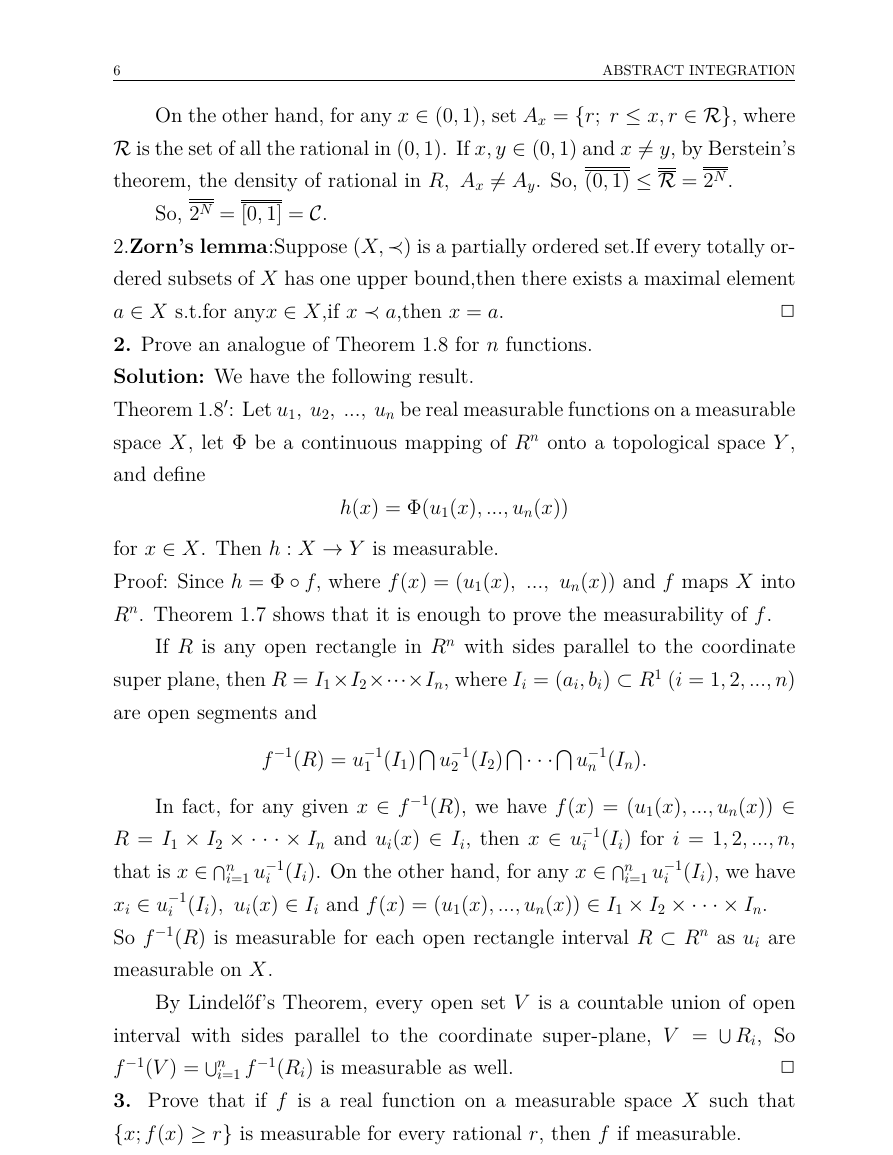
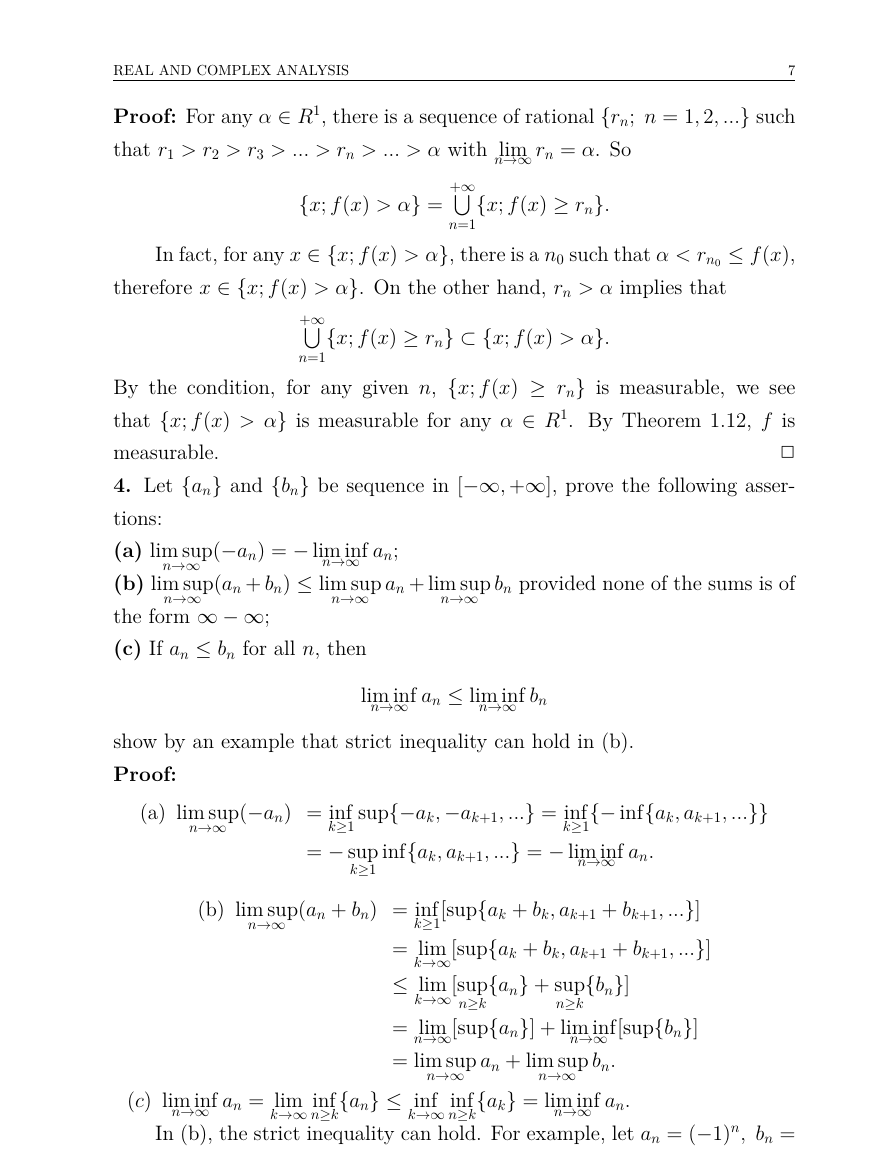
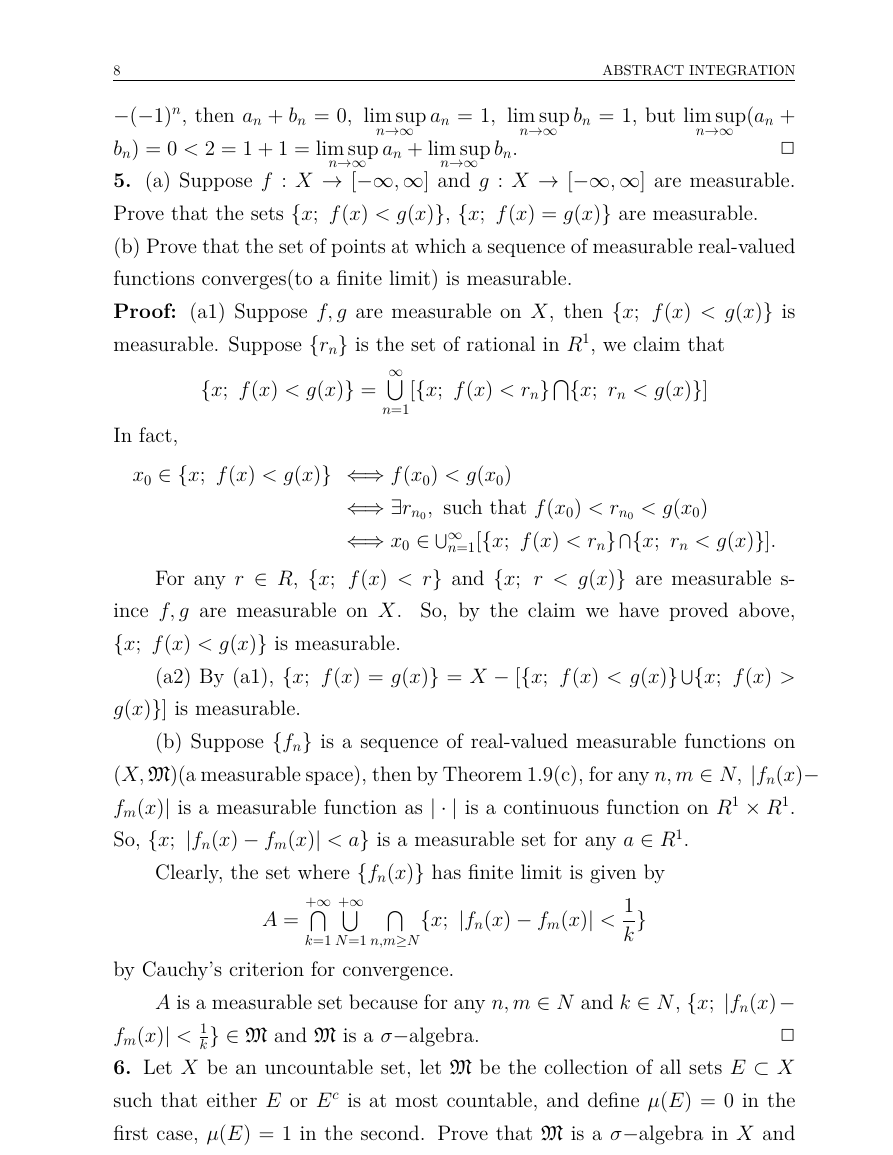








 2023年江西萍乡中考道德与法治真题及答案.doc
2023年江西萍乡中考道德与法治真题及答案.doc 2012年重庆南川中考生物真题及答案.doc
2012年重庆南川中考生物真题及答案.doc 2013年江西师范大学地理学综合及文艺理论基础考研真题.doc
2013年江西师范大学地理学综合及文艺理论基础考研真题.doc 2020年四川甘孜小升初语文真题及答案I卷.doc
2020年四川甘孜小升初语文真题及答案I卷.doc 2020年注册岩土工程师专业基础考试真题及答案.doc
2020年注册岩土工程师专业基础考试真题及答案.doc 2023-2024学年福建省厦门市九年级上学期数学月考试题及答案.doc
2023-2024学年福建省厦门市九年级上学期数学月考试题及答案.doc 2021-2022学年辽宁省沈阳市大东区九年级上学期语文期末试题及答案.doc
2021-2022学年辽宁省沈阳市大东区九年级上学期语文期末试题及答案.doc 2022-2023学年北京东城区初三第一学期物理期末试卷及答案.doc
2022-2023学年北京东城区初三第一学期物理期末试卷及答案.doc 2018上半年江西教师资格初中地理学科知识与教学能力真题及答案.doc
2018上半年江西教师资格初中地理学科知识与教学能力真题及答案.doc 2012年河北国家公务员申论考试真题及答案-省级.doc
2012年河北国家公务员申论考试真题及答案-省级.doc 2020-2021学年江苏省扬州市江都区邵樊片九年级上学期数学第一次质量检测试题及答案.doc
2020-2021学年江苏省扬州市江都区邵樊片九年级上学期数学第一次质量检测试题及答案.doc 2022下半年黑龙江教师资格证中学综合素质真题及答案.doc
2022下半年黑龙江教师资格证中学综合素质真题及答案.doc